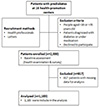| Korean J Health Promot > Volume 19(4); 2019 > Article |
|
ABSTRACT
Background
Methods
Results
REFERENCES
Table 1
Characteristics of the study subjects according to obesity status

Values are presented as mean±standard deviation or number (%).
Abbreviations: BMI, body mass index; DBP, diastolic blood pressure; FBS, fasting blood sugar; HbA1c, hemoglobin A1c; HDL-C, high-density lipoprotein cholesterol; LDL-C, low-density lipoprotein cholesterol; MA, microalbuminuria; SBP, systolic blood pressure; TC, total cholesterol; TG, triglyceride.
aThe Student's t-test or chi-square test were used.
Table 2
Microalbuminuria and clinical characteristics of study subjects according to the status of obesity and blood pressure

Values are presented as mean±standard deviation or number (%).
Abbreviations: BMI, body mass index; DBP, diastolic blood pressure; FBS, fasting blood sugar; HbA1c, hemoglobin A1c; HDL-C, high-density lipoprotein cholesterol; LDL-C, low-density lipoprotein cholesterol; MA, microalbuminuria; SBP, systolic blood pressure; TC, total cholesterol; TG, triglyceride.
aThe ANOVA or chi-square test were used.
Table 3
Association between hypertension status and microalbuminuria in non-obese and obese group

Model 1: a univariable logistic regression model. Model 2: a multivariable logistic regression model adjusted for sex, age, diabetes family history. Model 3: a multivariable logistic regression model adjusted for sex, age, diabetes family history, FBS, HbA1c, TC, TG, LDL-C, HDL-C.
Abbreviations: CI, confidence interval; FBS, fasting blood sugar; HbA1c, hemoglobin A1c; HDL-C, high-density lipoprotein cholesterol; LDL-C, low-density lipoprotein cholesterol; MA, microalbuminuria; OR, odds ratio; TC, total cholesterol; TG, triglyceride.
aOR and 95% CI are calculated with logistic regression.
Table 4
Analysis for evaluating the combined effect of obesity and hypertension status on microalbuminuria in the study subjects

Abbreviations: BP, blood pressure; CI, confidence interval; MA, microalbuminuria; OR, odds ratio.
aAdjusted for age, sex, diabetes family history, fasting blood sugar, hemoglobin A1c, total cholesterol, triglyceride, low-density lipoprotein cholesterol, high-density lipoprotein cholesterol.
bOR and 95% CI are calculated with multiple logistic regression.
-
METRICS

-
- 1 Crossref
- 0 Scopus
- 945 View
- 2 Download
- Related articles
-
Relationship between Sleep Time and Hand Grip Strength on Weekday and Weekend2020 March;20(1)





 PDF Links
PDF Links PubReader
PubReader ePub Link
ePub Link Full text via DOI
Full text via DOI Download Citation
Download Citation Print
Print


